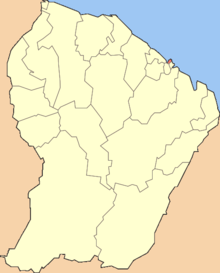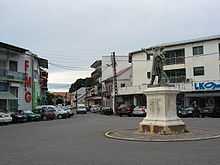Cayenne
| Cayenne | |
|---|---|
 | |
 | |
| Coordinates: 4°55′22″N 52°19′37″W / 4.9227°N 52.3269°WCoordinates: 4°55′22″N 52°19′37″W / 4.9227°N 52.3269°W | |
| Country | France |
| Overseas region and department | French Guiana |
| Arrondissement | Cayenne |
| Intercommunality | Centre Littoral |
| Government | |
| • Mayor | Marie-Laure Phinera-Horth |
| Area | |
| • Urban (2010) | 206.9 km2 (79.9 sq mi) |
| • Metro (2010) | 5,087 km2 (1,964 sq mi) |
| • Land1 | 23.60 km2 (9.11 sq mi) |
| Population (Jan. 2011[1]) | |
| • Urban (Jan. 2011[1][2]) | 106,358 |
| • Urban density | 510/km2 (1,300/sq mi) |
| • Metro (Jan. 2011[1][3]) | 121,308 |
| • Metro density | 24/km2 (62/sq mi) |
| • Population2 | 57,229 |
| • Population2 Density | 2,400/km2 (6,300/sq mi) |
| INSEE/Postal code | 97302 / 97300 |
|
1 French Land Register data, which excludes lakes, ponds, glaciers > 1 km² (0.386 sq mi or 247 acres) and river estuaries. 2 Population without double counting: residents of multiple communes (e.g., students and military personnel) only counted once. | |

Cayenne (French pronunciation: [kajɛn]) is the capital of French Guiana, an overseas region and department of France located in South America. The city stands on a former island at the mouth of the Cayenne River on the Atlantic coast. The city's motto is "ferit aurum industria" which means "work brings wealth".[4]
At the 2011 census, there were 121,308 inhabitants in the metropolitan area of Cayenne (as defined by INSEE),[3] 57,229 of whom lived in the city (commune) of Cayenne proper.[1]
Geography
Cayenne is located on the banks of the estuary of the Cayenne River on the Atlantic Ocean. The city occupies part of the Ile de Cayenne. It is located 268 km from Saint-Laurent-du-Maroni and 64 km from Kourou.[5]
Distances to some cities:
- Paris: 7,100 kilometres (4,400 mi).
- Fort-de-France, capital of Martinique: 1,500 kilometres (930 mi).[6]
- Paramaribo, capital of Suriname: 342 kilometres (213 mi) to the northwest.
- Macapá, capital of the state of Amapá, Brazil: 554 kilometres (344 mi) to the southeast.
History
![]() French colonial empire 1643–1658
French colonial empire 1643–1658
![]() Dutch Empire 1658–1664
Dutch Empire 1658–1664
![]() French colonial empire 1664–1676
French colonial empire 1664–1676
![]() English Empire 1667
English Empire 1667
![]() Dutch Empire 1676
Dutch Empire 1676
![]() French colonial empire 1676–1809
French colonial empire 1676–1809
![]() Portuguese Empire 1809–1817
Portuguese Empire 1809–1817
![]() France 1817–present
France 1817–present
Ignored by Spanish explorers, who found the region too hot and poor to be claimed, the region was not colonized until 1604, when a French settlement was founded. However, it was soon destroyed by the Portuguese, who were determined to enforce the provisions of the Treaty of Tordesillas. French colonists returned in 1643 and founded Cayenne, but they were forced to leave once more following Amerindian attacks. In 1664, France finally succeeded at establishing a permanent settlement at Cayenne. Over the next decade the colony changed hands between the French, Dutch and English, before being restored to France. It was captured by an Anglo-Portuguese force at the invasion of Cayenne in 1809 and administered from Brazil until 1814, when it was returned to French control. It was used as a French penal colony from 1854 to 1938.

The city's population has recently grown dramatically, owing to high levels of immigration (chiefly from the West Indies and Brazil) as well as a high birthrate.
Demography
| 1961 | 1967 | 1974 | 1982 | 1990 | 1999 | 2006 | 2011 | ||||
|---|---|---|---|---|---|---|---|---|---|---|---|
| Cayenne (commune) | 18,615 | 24,518 | 30,461 | 38,091 | 41,067 | 50,594 | 58,004 | 57,229 | |||
| Cayenne (metropolitan area) | 21,505 | 28,257 | 35,812 | 49,118 | 66,803 | 92,059 | 112,876 | 121,308 | |||
| Official figures from population censuses.[1][3] | |||||||||||
Average population growth of the Cayenne metropolitan area:
- 1961-1967: +1,122 people per year (+4.6% per year)
- 1967-1974: +1,079 people per year (+3.4% per year)
- 1974-1982: +1,799 people per year (+4.4% per year)
- 1982-1990: +2,206 people per year (+3.9% per year)
- 1990-1999: +2,812 people per year (+3.6% per year)
- 1999-2006: +3,054 people per year (+3.0% per year)
- 2006-2011: +1,686 people per year (+1.5% per year)
Economy
Cayenne is an important industrial centre for the shrimp industry. The city formerly also contained sugar refineries.
Culture
Cayenne is very ethnically diverse, with Creole, Haitian, Brazilian, European, and Hmong and other Asian communities. It is famous for its annual carnival which starts with the arrival of Vaval (the Carnival King) on the first Sunday after New Year's Day and continues with very popular all-night costume balls and Sunday afternoon parades every weekend until Mardi Gras.
Main sights

Cayenne centres on its main commercial street, the Avenue Général de Gaulle. At the east end of the avenue near the coast is the Place des Palmistes and the Place de Grenoble (also known as the Place Léopold Héder). Most of the official buildings are located in this area: the Hôtel de Ville (the town hall) built by Jesuits in the 1890s, the Post Office, the Préfecture, residence of French Guiana's Préfect, and the Musée Départmental Franconie. To the west of this area lies Fort Cépérou, built in the 17th century, though now mostly in ruins. To the south lie the Place du Coq and Place Victor Schoelcher (named in honour of the anti-slavery activist) and a market.
To the south of this compact region is the Village Chinois (known as Chicago), separated from the rest of Cayenne by the Canal Laussat. It has a reputation for being a dangerous area.
Other buildings in the city include the Cathédrale Saint-Sauveur de Cayenne, municipal library, the municipal museum and a museum of French Guianese Culture (Musée des Cultures Guyanaise) and a scientific research institute (IRD or Institut de recherche pour le développement, formerly Orstom). The Jardin botanique de Cayenne is the city's botanical garden.
Transport
Cayenne is served by the Cayenne-Rochambeau Airport, which is located in the neighbouring commune of Matoury.
Climate
Under the Köppen climate classification, Cayenne has a tropical monsoon climate. Average high and low temperatures are nearly identical throughout the course of the year averaging about 30 °C (86 °F) and 23 °C (73 °F) respectively. Cayenne sees a copious amount of precipitation during the year. The city features a very lengthy wet season and a very short dry season. The dry season only covers two months of the year (September and October) while the wet season covers the remainder of the year. Precipitation is seen even during the dry season, a trait commonly seen in places featuring tropical monsoon climates. Cayenne averages roughly 3,750 millimetres (150 in) of rain each year.
| Climate data for Cayenne | |||||||||||||
|---|---|---|---|---|---|---|---|---|---|---|---|---|---|
| Month | Jan | Feb | Mar | Apr | May | Jun | Jul | Aug | Sep | Oct | Nov | Dec | Year |
| Average high °C (°F) | 29 (84) |
29 (84) |
29 (84) |
30 (86) |
29 (84) |
31 (88) |
31 (88) |
32 (90) |
32 (90) |
32 (90) |
31 (88) |
30 (86) |
30.4 (86.8) |
| Daily mean °C (°F) | 26 (79) |
26 (79) |
26 (79) |
27 (81) |
26 (79) |
27 (81) |
27 (81) |
28 (82) |
28 (82) |
28 (82) |
27 (81) |
27 (81) |
26.9 (80.6) |
| Average low °C (°F) | 23 (73) |
23 (73) |
23 (73) |
24 (75) |
23 (73) |
23 (73) |
23 (73) |
23 (73) |
23 (73) |
23 (73) |
23 (73) |
23 (73) |
23.1 (73.2) |
| Rainfall mm (inches) | 431 (16.97) |
423 (16.65) |
432 (17.01) |
480 (18.9) |
590 (23.23) |
457 (17.99) |
274 (10.79) |
144 (5.67) |
32 (1.26) |
42 (1.65) |
122 (4.8) |
317 (12.48) |
3,744 (147.4) |
| Avg. rainy days (≥ 0.1 mm) | 23 | 20 | 21 | 19 | 25 | 26 | 21 | 14 | 6 | 5 | 11 | 21 | 212 |
| Mean monthly sunshine hours | 142.6 | 116.0 | 136.4 | 129.0 | 136.4 | 171.0 | 207.7 | 232.5 | 261.0 | 266.6 | 234.0 | 192.2 | 2,225.4 |
| Source: climatetemp.info[7] | |||||||||||||
Administration

Cayenne is the chief town of six cantons:
- The first canton (North West) has 3,935 inhabitants;
- The second canton (North East) has 5,730 inhabitants;
- The third canton (South West) has 8,017 inhabitants;
- The fourth canton (Centre) has 5,955 inhabitants;
- The fifth canton (South) has 9,750 inhabitants;
- The sixth canton (South East) has 17,207 inhabitants
Cayenne in popular culture
The French folk song Cayenne (named after the main city of French Guiana) tells the story of a pimp who shoots a well-to-do client who grossly disrespected a prostitute, and is then convicted and transferred to the infamous penitentiary.[citation needed]
In The Hardy Boys #12: Footprints under the Window, the Hardys' investigations take them to Cayenne.
The 1955 film We're No Angels involves three prisoners who escape from Devil's Island and settle incognito into a family store in Cayenne.
See also
References
- ↑ 1.0 1.1 1.2 1.3 1.4 INSEE. "Historique des populations par commune depuis 1961". Retrieved 2014-02-01.
- ↑ INSEE. "Base des unités urbaines 2010". Retrieved 2014-02-01.
- ↑ 3.0 3.1 3.2 INSEE. "Base communale des aires urbaines 2010". Retrieved 2014-02-01.
- ↑ "page concernant le blason de la ville sur le site page de Redris". Pagesperso-orange.fr. Retrieved 13 March 2011.
- ↑ Distances and duration of bonds in the dugout
- ↑ Situation Géographique Préfecture de Guyane, archived September 15, 2008 from the original
- ↑ "Cayenne, French Guiana Weather Averages".
External links
| Wikimedia Commons has media related to Cayenne. |
- Préfecture de Guyane Official website
| ||||||||
| ||||||||||||